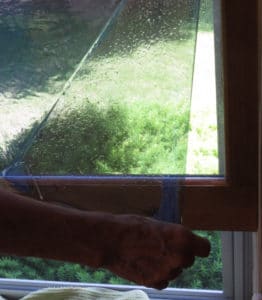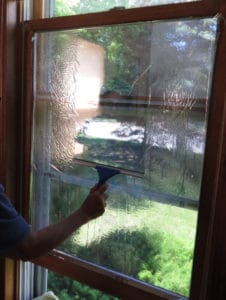Kanil writes: I need to build a few interior storm windows by mounting energy-saving clear window film to contain the heat, but still have high light transmission.
I have seen a lot of articles online that mention clear low-E window films with high VT (visible-light transmission). But I couldn’t find a commercially available film of this kind.
Could you please recommend a brand name or source of such a window film? Thanks
Steve Bliss, of BuildingAdvisor.com, responds: A low-E film with high visible light transmission would provide insulation and solar control without blocking your view. However, window films are made to apply to glass, not installed in a frame. To build low-E storm windows, you need to use hard-coat low-E glass.
Perhaps you are thinking of Heat Mirror, a high-performance low-E film originally developed by Southwall Technologies (now owned by Eastman Chemical Co.). Heat Mirror is stretched in a frame, but must be suspended in a vacuum between two panes of sealed glass. It is used to create high-performance triple- and quad-pane windows without the added weight of extra panes of glass. For obvious reasons, it is not a DIY product.
The simplest way to add low-E storm windows is to have them fabricated out of hard-coat low-E glass by any glass shop or window contractor. Or you can purchase the low-E glass yourself and build the frames. Adding storm windows will reduce air leakage, while roughly cutting heat loss in half though the glass. You will also reduce UV-transmission that contributes to fading and modestly reduce solar gain.
Adding a low-E storm window to a single-glazed window will boost the R-value from approximately R-1 to R-2.5 (vs. R-2 for a standard storm window). The low-E storm will reduce the SHGC (Solar Heat Gain Coefficient) from about 0.7 to 0.5, about a 30% reduction in heat gain. The storm window will also reduce air leakage. You can read more on the SHGC below.
Hard-coat low-E does not perform as well as “soft coat,” a microns-thick film applied to the inner surface sealed double glazing. However, the hard-coat surface is baked on and can survive exposure to weather and washing, which would destroy soft-coat low-E. If you’re going to the trouble of building storm windows, the extra cost of low-E glass is worth the modest extra cost.
Adding low-E storm windows on the interior or exterior to single-pane windows will improve comfort in cold weather and will provide a reasonable payback based on energy savings. Results will vary a lot depending on the climate, energy costs, window material, and leakiness of the prime windows. In a well-controlled study by the US DOE, low-E storm windows in Richmond, WA, reduced heating bills by about 10% and cooling bills by about 8%, and had a simple payback period of 5-7 years. Other studies cited in the DOE report found savings on heating bills ranging from 15% to 22% .
If you are starting with double-glazed windows, the savings from adding a storm window will be roughly half as much and the payback period twice as long.
There are a number of window films on the market that you can apply to the inside surface of the glass. Most install with soapy water and a squeegee, but some install dry. Most window films are tinted or reflective and are designed mainly to reduce solar gain during hot weather. They also reduce glare the and fading of fabrics from UV light. However, they won’t add significantly to R-value or reduce air leakage like a storm window.

Some of the consumer films, such as Gila Heat Control Residential Window Film, claim to be low-E, but the manufacturer was unable to provide me with any technical or test data to support that claim. (A normal reflective surface typically has a lower emissivity rating than a non- reflective surface, but does not achieve the same performance as a true low-E film). I would recommend applied films like this for solar control only.
For effective blocking of solar heat gain, the Florida Solar Energy Center (FSEC), a leader in hot climate energy research, recommends a film (or window) with a Solar Heat Gain Coefficient (SHGC) of under 0.5 and preferably below 0.3. By comparison, a new window used must have an SHGC of 0.25 or less to earn a DOE Energy-Star rating for use in hot climates, and 0.40 or less in mixed climates. The SHGC is essentially the percentage of solar (heat) energy that passes through a window into your house. The rest is either reflected back outdoors or radiated back from the heated glass.
Unfortunately many tinted window films block visible light transmission as much or more than they block solar heat gain and may look glaring or heavily tinted from outside. Before installing these, it’s a good idea to test visibility from indoors and the appearance from outdoors. In general, the greater the reduction in heat gain, the more visible is the tint of the film.
I am aware of only one clear, low-E window film on the market — 3M’s Thinsulate Climate Control Window film. The applied film has very good visibility (high visible light transmission), and will provide a modest boost in R-value along while reducing solar gain and fading. It is used mainly commercially and installed only by licensed installers. If you have single-glazed windows, adding low-E storms would provide better insulation and reduce air leakage.
If your primary windows are in rough shape and you are looking for superior energy performance, you may wish to consider full replacement windows. Look for windows with “selective” low-E glass, which is now standard on most premium new and replacement windows. These windows combine high insulation values with high visible light transmission, while rejecting solar heat gain. (For passive-solar homes, you will need to special-order high solar heat gain windows). If the performance numbers are too confusing, just look for an Energy-Star label.

Applying Window Films
On our oversized west-facing windows in our current home (double-glazed) we recently installed Gila Heat Control Residential Window Film – Platinum. You can apply it with soapy water and a squeegee as we did, or can purchase a commercial solution from the manufacturer. If you take your time to work out all the bubbles, you can get a pretty good installation, but not perfect.
Remember to leave a 1/8” gap around the perimeter of the applied film to avoid peeling and other problems. I measured the temperature just inside the window on a very hot day and found a 3-4 degree temperature reduction with the film – not amazing, but so far, so good.
Mark Strovink says
Heat-Control Film For Storm Door?
I just replaced my hail-damaged storm door with one from Larson that claims Low-E glass. My blue enamel painted metal front door now gets hotter “protected” by the Larson Low E glass than the old storm door.
After your experience with the Gila heat control film, do you think it would make a significant difference keeping the morning sunshine from overheating the door?
Would it be safe to apply the film to the inside of the Larson Low E glass?
Hope you know!
Thanks, Mark
buildingadvisor says
Low-E storm windows are “hard-coat,” meaning that the coating is fused to surface of the molten glass forming a durable layer that is difficult to scratch and can be exposed to the air. Soft-coat low-e needs to be protected within a sealed glass unit.
Hard-coat low-e has a much higher solar heat-gain coefficient (SHGC) than soft-coat, so more solar energy passes through, heating the space between the two doors. Hard-coat low-e has an R-value between regular glass and soft-coat low-e, helping trap the heat. Even standard glass will trap heat here due to the “greenhouse effect,” which is ability of all glass to block long-wave infrared radiation, that is, the heat energy radiating back from the hot door surface.
So you’ve created a pretty effect solar collector between your storm door and front door. It would be safe to apply a heat-control film, such as Gila’s, to the storm window. How much it will reduce the temperature would be extremely difficult to calculate even if I had the technical specs on the film, which Gila was unable to provide me. The advantage of the Gila film over standard solar-control films is that the tint is less noticeable from the exterior.
Painting the door a light, reflective color (white is best) will also reduce the temperature between the doors. Good luck and let me know how you make out.
Mark says
Hi Steve,
My wife didn’t like the mirror effect from the Gila Titanium so I tried “fancy-fix Sun Heat Control Solar Window Films Ceramic Series Clear Window Glass Tint” at this link on Amazon.
Didn’t help enough to notice.
I have some summer window screens with Phifer Sun Tex 90 solar shading fabric. I leaned a large one in front of the storm door and that kept the blue front door from getting hot. Now I’m working on how to attach solar shading fabric to the screen door.
Best regards,
Mark